F-22 - Answers to Questions
Recently, a lot of publications on the F-22 appeared in the network and in the press, which are mainly divided into two camps. The first includes enthusiastic psalms of miracles.weaponswhich is capable of waging a battle with any enemy in numbers on the sea, land, in the air and under water. Subtle, super-maneuverable, both on a subsonic and at a supersonic speed plane, with which aircraft of the previous generation are simply not capable of fighting. The second camp combines articles and statements such as the “Reptor” - a suitcase with wings, stuffed for 200 million with all kinds of electronics, which, in principle, can fly, but he doesn’t really need it. True, it is not clear how he at the same time demonstrates all these tricks at an air show, or maybe it is not him? Maybe all this was shot in the studio by the damned Americans, like the moon landing?
Meanwhile, in the shadow of heated debate and a spray of saliva, the important fact that the Americans created a fundamentally new combat class remained unnoticed aviation techniques, which we will discuss in detail at the end. And now the promised answers to questions on F-22 aerodynamics.
• How does the F-22 maintain good stability and controllability at high angles of attack, without using such aerodynamic tricks as sagging, CIP, ledges on the leading edge of the wing and other aerodynamic elements characteristic of the 4 generation fighters?
In fact, the “Raptor” has the same whirling aerodynamics as the 4 generation fighters. The invisibility requirements imposed on her extremely severe restrictions. The edge on the lateral surface of the forward fuselage, the vortex-forming upper edge of the air intake and a small influx in the root of the wing (Fig. 1) are responsible for the formation of the vortex system. The experimental development of the upper edge of the air intake was particularly difficult. Here, several conflicting requirements came together: stealth, air intake operation, vortex rope generation, road stability, etc.
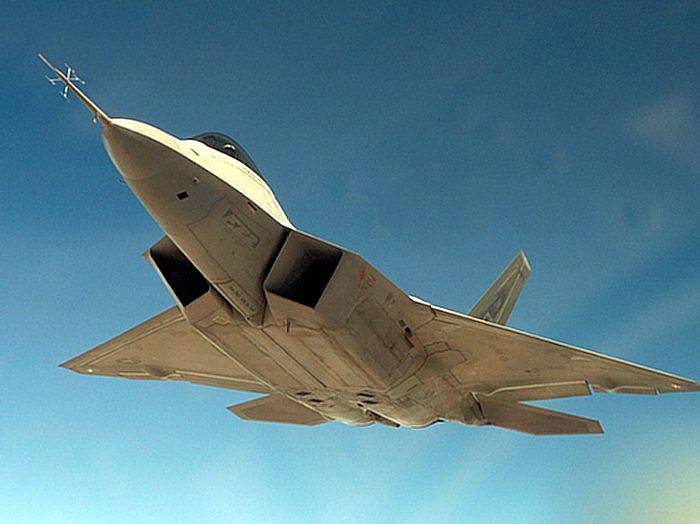
Figure 2, 3 shows the vortex system, which is formed by the nose section of the F-22 fuselage. The left figure shows the vortex system in a continuous flow. The vortex bundles from the upper edge of the air intake and the rib of the nose part flow along the keels from both sides, and the eddies from the influxes - the wing and the horizontal plumage. With the development of tear-off phenomena (dark area in the right figure), the flow pattern changes. Vortex harness detaches from the edge of the air intake and turns into a vortex sheet, which does not allow to develop areas of separated currents and thus maintains the effectiveness of vertical tail to angles of attack of the order of 30 degrees. At high angles of attack, the property of the wings of small elongation begins to have a positive effect, which is associated with a large angle of sweep of the leading edge. Due to the large difference in pressure, gas begins to flow from the lower surface of the wing to its upper surface through the leading edge, this forms a vortex, prevents separation from the upper surface of the wing and maintains the efficiency of the tail (fig. 4).
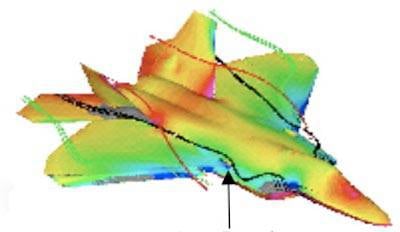
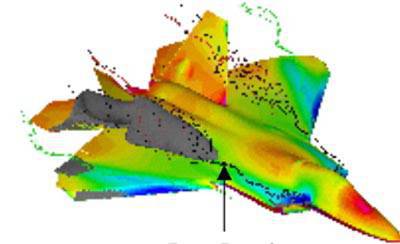
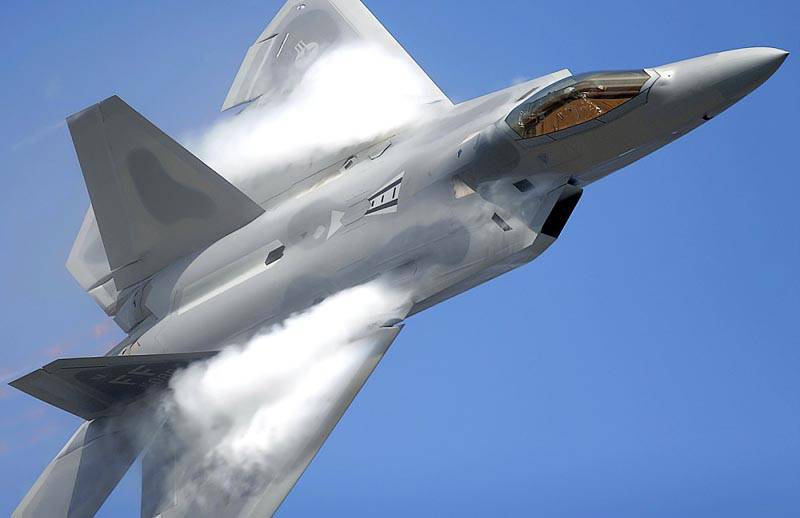
Of course, the classic rush of the wing would be better. After all, he solves another problem. When passing through the speed of sound, the aerodynamic focus shifts back, as a result, the margin of static stability increases and additional balancing resistance occurs. The influx at supersonic speed creates a lifting force (it is small at the subsonic), which weakens the focus shift backwards and reduces the balancing resistance (Fig. 5). The "Raptor" at the forefront of stealth. But what about additional resistance? The engine is powerful, there is a lot of fuel, so you can put up with it.
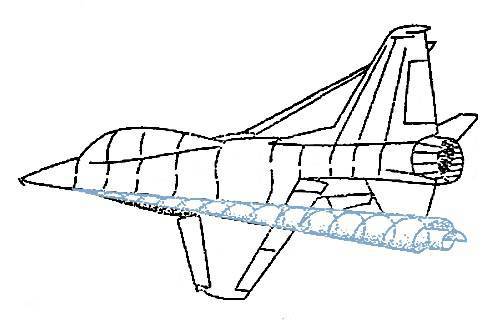
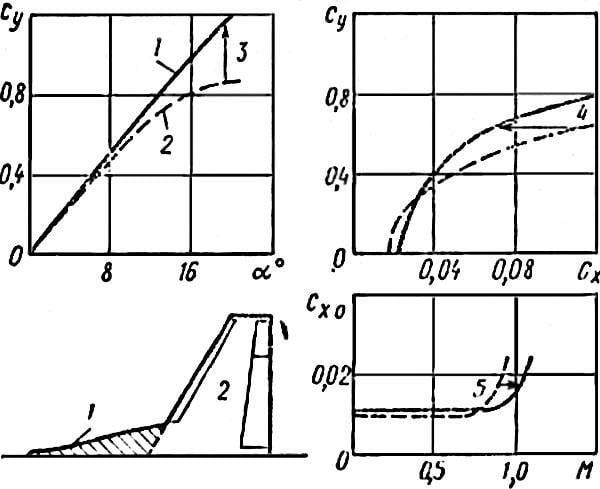
Another thing is that the Russian X-NUMX + generation fighter aircraft used the full range of aerodynamic improvements, which allows to increase the aerodynamic quality in a wide range of Mach numbers and angles of attack. This was discussed in detail in the second part of the work [4]. Almost all of them the developers of "Raptor" had to be abandoned in favor of stealth.
• Where does “Raptor” have such angular speed of roll and rotation, which it demonstrates at exhibitions, because it is typical, it seems, for airplanes of the “tailless” scheme? Maybe it is in the differential deviation of the thrust vector?
In fact, for all airplanes with a small elongation of the wing, and not just the tailless scheme, a more favorable distribution of aerodynamic loads is typical for the span than for wings with a small sweep, such as the MiG-29, F-16, F-18 . The best in this regard, the aerodynamic configuration is a "duck" with a near-front horizontal tail (GIP). It is considered as such if the main wing is located in the zone of action of the bevel of the stream from the tail. Such a scheme is also sometimes called a “biplane - tandem”. The introduction of the pioneers were the Swedes with their "Wiggen" (Fig. 6). The Israeli Lavi was built in the same way.
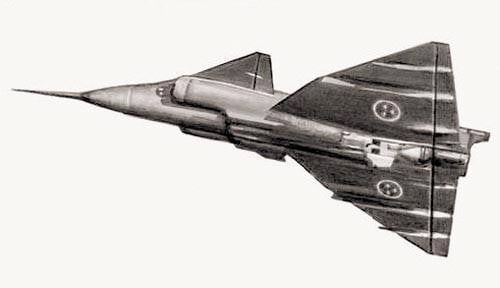
The combination of a small moment of inertia about the longitudinal axis of single-engine airplanes and a large area of transverse control bodies located along the entire trailing edge of the wing allows for a high rotational speed. The best among them is the Mirage-2000. In this regard, it is interesting to compare the F-15, F-16 and F-22 heel rates (Fig. 7; circles are marked with thrust vector control (UHT) turned off, with squares with UHT turned on). Since the F-15 is twin-engine and has a moderately swept wing, and the F-16 is single-engine, the Falcon should take precedence. The "Raptor" engines are located near the center of mass, the wing of small elongation, a large sweep of the leading edge and a very large tail. Theoretically, it should be somewhere in the middle.
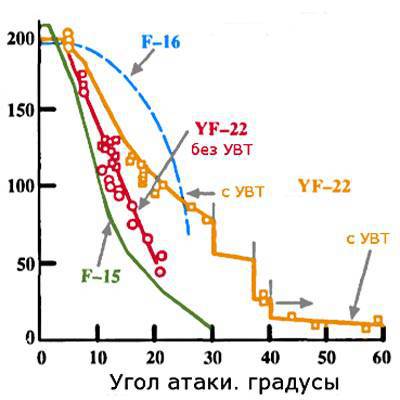
At zero angle of attack, all three fighters are approximately equal by this indicator (about 200 degrees / sec.). As the angle of attack increases, F-16 comes forward and retains its flesh advantages to 30 angles. even in the case of "Raptor" thrust vector control. And only at high angles of attack, the advantage goes to the F-22. The outsider, as expected, was F-15.
In fig. 7 shows that the F-22 heel rate without UHT is already at an angle of attack of about 20 degrees. almost equal to that of the F-15. It is known that the nozzles of the Raptor engines are locked just in time for the 20 angle of attack. To control the yaw angle and roll angle at high angles of attack is connected UHT. In this case, the nozzles are deflected in one direction, and not differentially, as strange as it may seem at first glance. At high angles of attack, as the angle of heel changes, the slip angle also changes. When rotating around the velocity vector, the nozzles deflect upward and the aircraft behaves like a rear-engined car in a steering-driven corner. The roll rate increases significantly. If it is necessary to carry out rotation around the longitudinal axis of the aircraft, then this maneuver is performed without changing the angle of attack. Previously, these maneuvers were worked out on the X-31. Rotation is performed due to the differential deviation of the tail and the deviation of the nozzle flaps, then one, then the other side.
• How does the F-22 so well manage the yaw angle when performing maneuvers at high angles of attack with slip? It seems that he freely performs a controlled flat corkscrew. The thing is raznotyag engines?
What the show on the “Raptor” show is not a flat corkscrew, but rotation around the velocity vector (fig.8) at angles of attack over 55 hail. Since the roll rate at such angles of attack is only a few degrees per second, and the precession speed is several tens of degrees / sec, it seems that the plane falls like a maple leaf, and this looks like a corkscrew, but this is not a corkscrew.
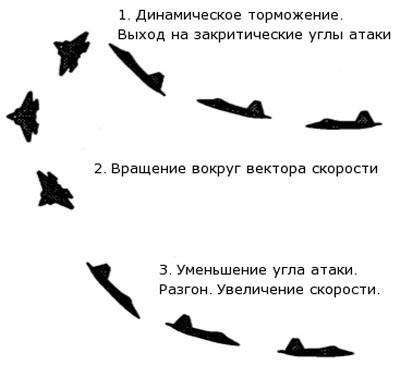
By repeating the maneuver shown in Figure 8 several times, the pilot can create the illusion of a flat spin in the viewer, which is what the Americans use at the airshow. Recall once again that the nozzle during the rotation of the "Raptor" deviate only synchronously. Theoretically, nothing prevents to deflect the nozzles differentially. There are no special mechanical connections that prevent this. However, from the point of view of the flight dynamics of the F-22, this is completely ineffective. The nozzles are placed too close to each other and to the center of gravity. In addition, the nozzles start to work only at angles of attack greater than 20 degrees., With this the maximum deflection angle is exactly 20 degrees, i.e. to reject them in different directions does not make much sense. Densely located flat supersonic design jets have a high ejection capacity; therefore, the upward deflection of both nozzles stabilizes the flow near the upper surface of the tail fuselage between the vertical tail, which contributes to the stability of the track, as well as the effectiveness of horizontal rudders.
• How does F-22 use UHT in close combat and can this “iron” win melee from the 4 generation fighter without using UHT?
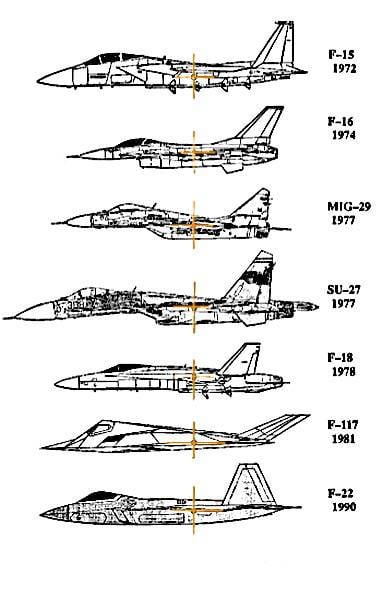
"Raptor" is characterized by a low load on the wing and high thrust-to-weight ratio, clean aerodynamic forms, and an internal weapons compartment. However, its wing has a high inductance, flat profiles with poor carrier properties. The fuselage is oversized in the area of the center section due to the need to place four compartments of weapons.
It is known from the theory that a fighter with high suo will have an advantage at low angles of attack, and at low angles of attack - with a small suo. Consequently, the “Raptor” in battle should immediately go to the angles of the order of 20 hail. where due to the high thrust-weight ratio he must have superiority. And do it as quickly as possible, i.e. the rate of increase of the angle of attack should be as large as possible. Comparing the balancing schemes of different fighters (Fig. 9), we can conclude that the creators of F-22 also knew about this.
The "Raptor" extremely close to the center of mass located engine nozzles and a very large horizontal tail, rendered back. Such an aerodynamic scheme provides twice as much moment in angle of attack than that of the F-16 without any UHT (Fig. 10). Applying deflection nozzles only increases the advantage.
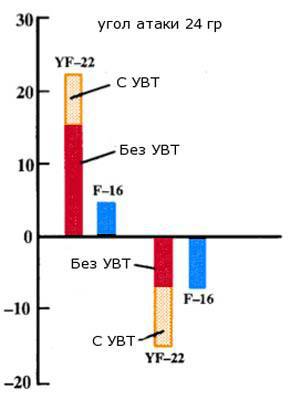
Thus, "Raptor" has the opportunity, how to enter into a close maneuverable battle with an 4-generation fighter on an advantageous mode, and get out of it. Moreover, the high thrust-to-weight ratio gives him an advantage in steady turns, which he performs up to the angle of attack 16 – 22 hail. (The majority of fighters of the fourth generation to 10-12 deg.), with Mach numbers M = 0.5-0.8. In F-16, the maximum speed of the steady reversal is reached at the angle of attack near 11.
The Americans have achieved a fairly good result, i.e. were able to give their fighter new qualities (supersonic speed and the ability to maneuver at M> 1), while providing him with an advantage in traditional modes. Another thing is that it was announced that it was quite different. They promised a decisive superiority.
The situation is different with the fighters of the 4 + and 4 ++ generation. Many of them have mastered maneuvers at supercritical angles of attack and angular turning speeds up to 30 degrees / sec. It will be difficult for “Reptoru” to fight them on the established turns. The only thing that was demonstrated at the “Reptor” from the arsenal of super-maneuverability is a “temporary increase in the pitch angle” for pointing the weapon (Fig. 11). With just two missiles on board, an aircraft for 200 million dollars in melee might not be lucky.
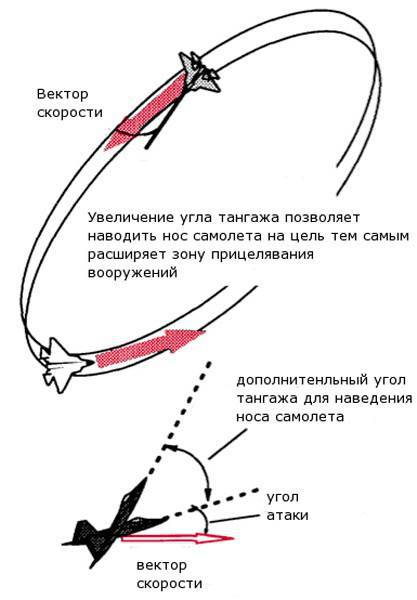
• Is the F-22 supermaneuverable, is the UHT used on the F-22 to increase maneuverability (decrease the turning radii, increase the angular speeds of the turn), and why is not the UHT applied at supersonic speed?
UHT is not used at supersonic speeds, because the fighter does not have enough engine thrust for this. Recall that the available overload at M> 1 drops by an order of magnitude [1]. In ballistic missiles, for example, guided nozzles are a common technical solution, but the thrust-to-surface area ratio is an order of magnitude higher.
With the F-22, the deflectable nozzles are used only at low speeds and high angles of attack, when the efficiency of aerodynamic control surfaces is not enough (Figure 12).
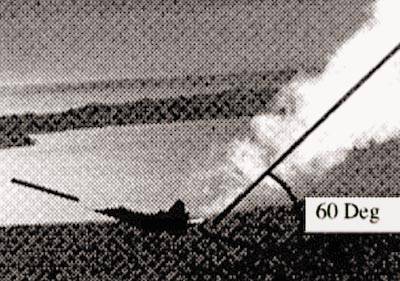
The symmetrical deflection of both nozzles is used to control pitch and roll to enhance the effect of horizontal tail at low speeds and high angles of attack. The use of deviating nozzles increased the mass of the structure by 15 ... 25 kg, while an equivalent increase in the area of the horizontal tail would increase this mass by 180 kg.
To create the effects of super-maneuverability UHT is not used. Here it is necessary to recall how the super-maneuverable aircraft of the 5 generation in the 1980-s was presented. It was believed that this would be a relatively small, inexpensive and very maneuverable aircraft (Fig.13).
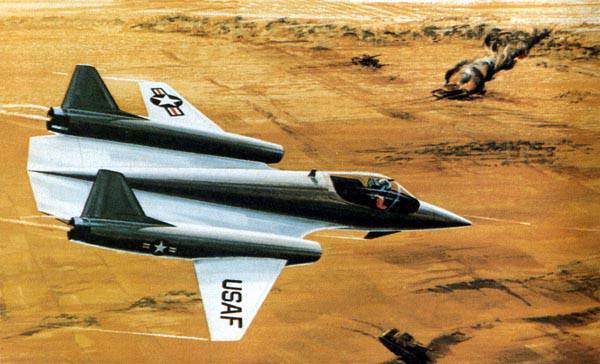
UHT was to be used to create direct lateral forces, i.e. participate in conjunction with the aerodynamic controls in controlling the spatial position of the aircraft, regardless of the trajectory of movement (Fig. 14) and the trajectory, regardless of the spatial position of the aircraft (Fig. 15).
Super-maneuverability allows to reduce the overload acting on the aircraft and the pilot, as well as to expand the scope of the weapon. Especially a wide range of opportunities for designers provides an all-nozzle. Equipped with such nozzles, the plane is theoretically capable of performing highly unconventional types of maneuvers, for example, evasion from air-to-air. “Raptor” doesn’t know how to do this and will never be able to, it just doesn’t need it, it was conceived by something completely different, supersonic, subtle and just relatively manoeuvrable.
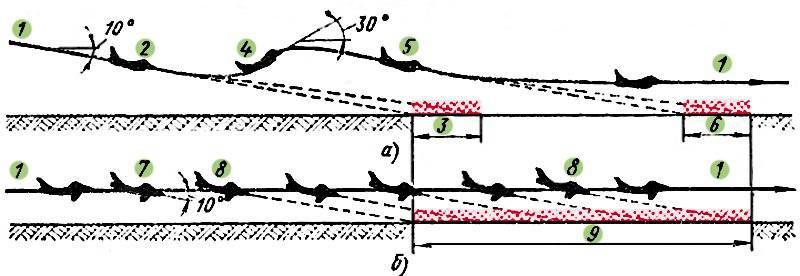
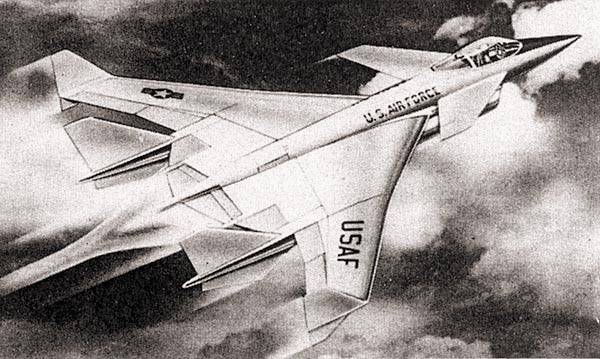
Then several other trends prevailed. By the beginning of the 1980-s, the 5-generation fighter began to be represented by a large, somewhere over 35 tons, but super-maneuverable aircraft, on which UHT nozzles and a variety of aerodynamic controls were to be used (Fig. 16). To study their effectiveness, radio-controlled models were developed on the 1: 2 scale (Fig. 17).
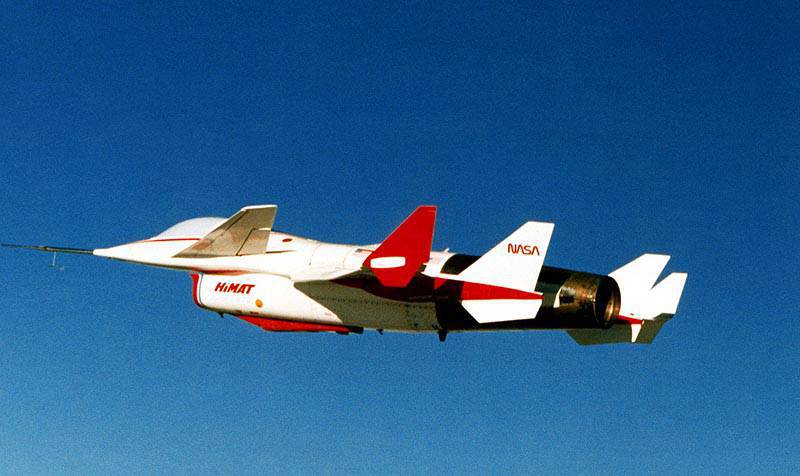
The next approach to the final development of the concept of the 5 fighter generation was the AFTI program, during which it was planned to build experimental aircraft using a modular principle (Fig. 18).
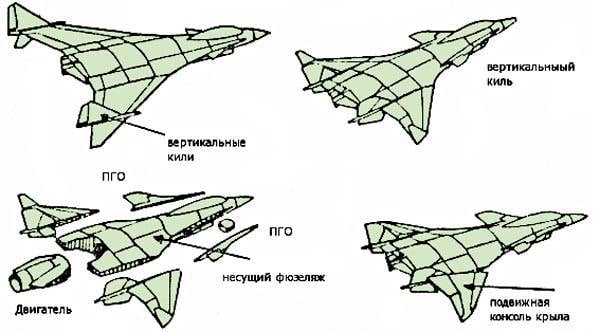
In the process of research, round and flat nozzles, different versions of controls, including a full-turn wing, were compared. The “triplane” scheme was considered mandatory for the direct control of lateral aerodynamic forces. All these innovations promised the fighter non-traditional capabilities in maneuverable combat, and the large size - a long range and significant ammunition.
The 4-35 ton aircraft equipped with 37 – 12 short, medium and long-range missiles, equipped with two engines of 14 – 20 tons with UHT, 22 – 10 control aerodynamic surfaces, and self-defense systems review. It could look something like the funny pictures of Chinese comrades (Fig. 14, 19). Now, by the way, this model is used in a computer game.
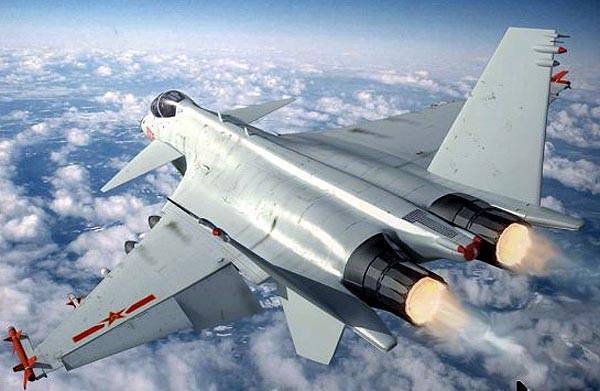
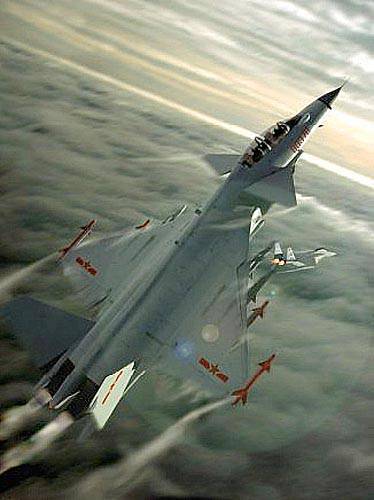
The concept of application in those early years saw something like this. Fighters, equipped with a powerful radar, maneuvering at supersonic speeds, fire at the enemy in a volley. We didn’t particularly care about stealth; it was believed that in order to impose their initiative in battle, radar should be turned on, and there it was no longer enough to be inconspicuous. It was believed that such a fighter cruise missiles could attack from a distance of at least 25 km, and enemy fighters from a distance of 50 – 70 km. In melee combat, the super-maneuverability and the circular self-defense complex were to ensure the launch of rockets, both in the forward hemisphere and in the rear.
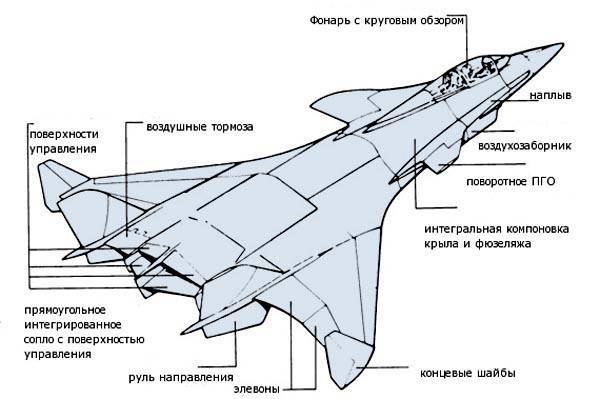
It gradually became clear that by moving to new technologies and removing weapons in the weapon compartments, the aircraft could be made much more compact. A greater degree of integration of the wing and fuselage allowed to increase the proportion of fuel in the mass of the aircraft, and new advances in aerodynamics - to reduce cruising fuel consumption. As a result, an airplane of dimensions from 20 to 30 t according to the “duck” scheme, with a strongly flat-bearing fuselage, was obtained. With such a scheme, it was washed to use flat nozzles, since one could count on the effect of supercirculation. An example is shown in Fig. 21, isn't it a bit like our MiG - 1.42.
And what of all this rich groundwork did Lockheed use in the F-22 project?
NOTHING. ANIMAL ACCOUNT ANYTHING. “RAPTOR” - NOT SUPERMANEUROUS.
• They write that a significant part of the thrust creates an air intake. But then how are they balanced and where are the forces applied when the flaps of the flat nozzle are deflected?
Indeed, at supersonic speeds, the air intake creates significant traction. It is not difficult to explain this by considering the design of the supersonic air intake (fig.22). Behind a direct closing shock, the current is subsonic. In the expanding part of the air intake (diffuser), the flow continues to be inhibited. Since the pressure in it is higher than in the environment, the distribution of pressure on the inner walls gives the resultant forward direction.
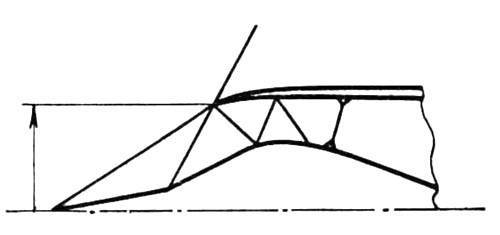
For the creation of engine thrust is the law of conservation of momentum. The plane does not repel air from a jet stream, propeller or compressor, as many people think so far. Best of all, the principle of the WFD, including UHT, is described in a rather old book [2], but, according to the drivers, since then the best textbook has not been published. In general, it consists of the following. The air intake and the compressor serve to compress the air. This is necessary for its supply to the combustion chamber in an amount sufficient for burning fuel in the optimum ratio with it. The resulting combustion products rotate the gas turbine, which drives the compressor through the shaft. Next, the gases enter the nozzle. In order for the aircraft to move it is necessary that the speed of the jet outflow from the nozzle is greater than the speed of the aircraft.
To which parts of the engine are applied the thrust force is not so important, but it is convenient to trace it in the Pv diagrams (pressure - speed increment). In areas of the engine where the speed increases, a thrust force arises. It can be seen that the majority of the thrust is generated by a nozzle (fig. 23).
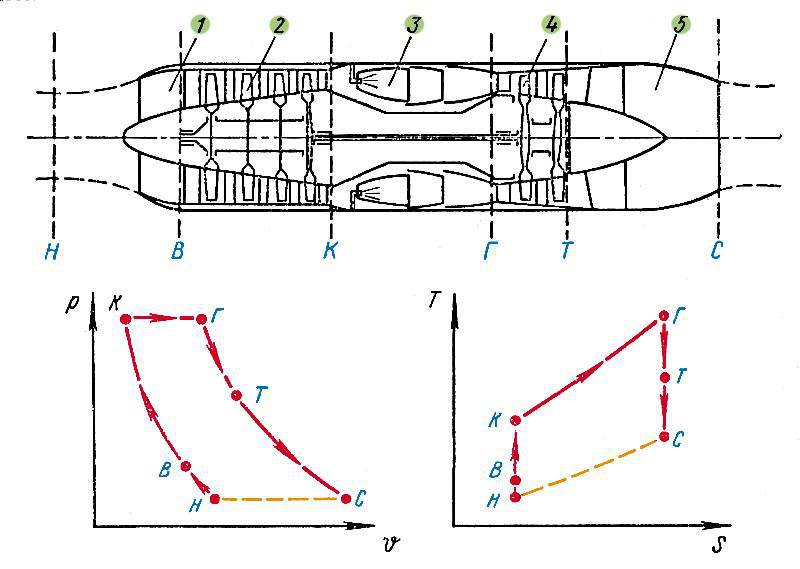
The compressor (section BC), on the contrary, creates resistance. Since, the law of conservation of momentum is a vector, the deviation of the jet allows one to obtain a thrust directed in the opposite direction. The force is applied to the walls and flaps of the nozzle. Here is a confirmation that the UHT on the F-22 is not used directly to increase maneuverability. There is nothing to balance emerging moments. On the contrary - UHT is used for balancing. On the MiG-29OVT this problem is not, because nozzle axes are spaced apart, and the nozzles themselves are all-view, the thrust vector can be directed through the center of mass. There are no problems on the duck planes. Here PGO is used for balancing.
• Why are all-angle UVT nozzles effective only at afterburner?
This, perhaps, from the field of curiosities. This, apparently, is about the MiG-29 and the UHT CLIVT system of NPO. Klimov. In this thrust vector control system, not all of the nozzle, as in the Su-30, for example, deviates, but only the flaps of the supercritical part of the nozzle. When the afterburner is turned off, the RD-33 nozzle reduces the diameter of the critical section. With this configuration, the flaps of its supersonic part simply cannot be rejected.
Recall also that UHT makes sense where there is a lack of efficiency of aerodynamic control surfaces. On such modes, flying without afterburner is unlikely to occur to anyone.
To understand that the afterburner itself is not related to the effectiveness of shock wave therapy, we must remember the principle of its operation. Afterburner is installed behind the turbine and only heats the combustion products, increasing their internal energy. Additional fuel could be burned in front of the turbine, if it could withstand and would not have to adjust the compressor. And it would be possible, theoretically, to put an electric heater. The main thing is what will be the total pressure and temperature of the gas in front of the nozzle.
• Why is a flat nozzle applied on the F-22 and a round nozzle on the F-35, what are their advantages?
The drawbacks of a flat nozzle are well known: heavy weight, loss of thrust, bending loads. In the F-35 variant for the Marine Corps, these factors are critically important, but the stealth, just fades into the background. Therefore a round nozzle is selected (fig. 24).
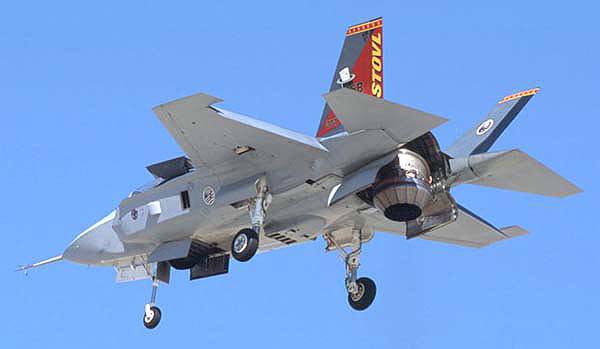
Gas dynamics know another serious drawback of flat nozzles, which complicates their use on airplanes with KVP. At the points of transition of a circular cross section into a rectangular one, strong nozzle shocks appear (Fig. 25).
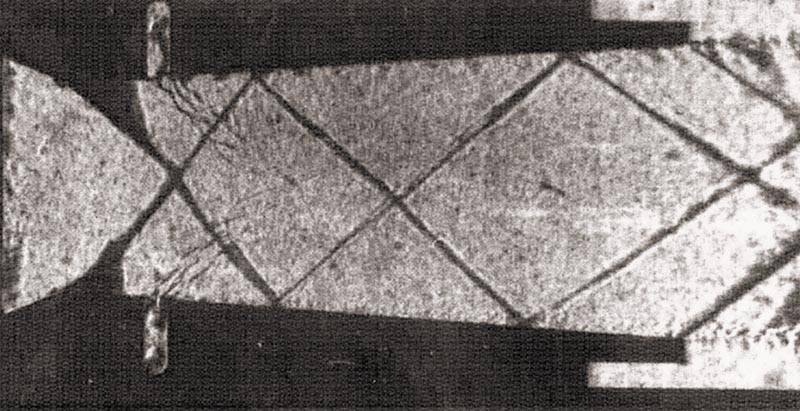
In round nozzles there may also occur nozzle jumps, but weaker ones. For the destruction of nozzle jumps in the flat nozzles can be installed longitudinal partitions, as in the F-117. On short-range take-off and landing airplanes, nozzle jumps cause strong erosion of the airfield cover.
At the same time, flat nozzles are well assembled on supersonic aircraft with flat fuselages. They can significantly reduce the bottom pressure at supersonic speeds, which can create up to 40% resistance. For the F-22 this is crucial. In addition, the flat nozzles relatively simply allow to use such aerodynamic effects as the Coanda effect (jet sticking to a near surface) and the effect of supercirculation, which significantly increase the aerodynamic quality of the aircraft. This was partially used on the YF-23.
• What is the notorious radar blocker inside the F-119, how much does it affect the loss of traction?
This device is shown in Fig. 26 and is a kind of impeller. It closes the turbine blades from the enemy’s radar station. The turbine blades are profiled and reflect the waves in all directions no worse than corner reflectors. At the same time the blades, which are visible in the photo, cover up the hot elements of the afterburner of the infrared-guided missile heads. Since the gas accelerates mainly in the nozzle, and the radar blocker is installed in front of it, in an area where the flow velocity is small, the loss of thrust is relatively small. In any case, they are smaller than the losses caused by the transition from a round nozzle to a flat one.
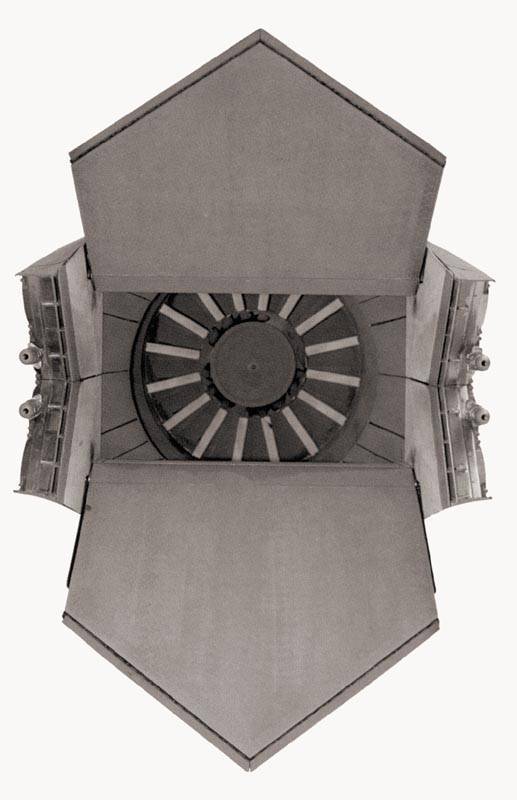
• With the F-119, it is not clear where the air from the second circuit is located. It seems to be the classical DDRDF scheme that involves taking air into the second circuit after the fan and mixing the flows of the first and second circuits behind the turbines, in front of the afterburners. And with the F-119, secondary air is used only for cooling. It turns out that it is single circuit? Or drawings published on the manufacturer's website - disinformation?
There are two TDRD schemes, with and without flow mixing. Since the main flight mode is unformed, why is it surprising that the chosen scheme without mixing the flow? The fan creates some of the thrust. Further, the air from the second circuit is discharged into the environment, but this does not make the engine single-circuit. In engines for which the afterburner mode is basic, for example, in the D-30F, the flows are mixed in front of the afterburner.
• Findings. F-22 as a new class of combat aircraft.
IN THE FIRST DISCUSSIONS ABOUT THE ESSENCE OF THE Fighter OF THE FIFTH GENERATION, THE MOST IMPORTANT FACT REMAINED IN THE SHADOW - AMERICANS CREATED A NEW CLASS OF AVIATION TECHNIQUE. By analogy with the main battle a tank F-22 could be called the main combat aircraft. This is the first combat aircraft, which can almost equally play the role of both an interceptor and a front-line bomber. World aviation has been going to this event for 40 years. How did you manage to achieve this and why didn’t it happen earlier?
The first attempt to create a universal aircraft ended with the appearance of the first-class F-111 bomber, which has not been surpassed in the United States so far. Then they tried to create a multi-purpose vehicle based on the F-15 fighter. The resulting F-15E acquired the ability to attack ground targets, while maintaining high potential in aerial combat. He had no direct analogs for a long time, perhaps, right up until the advent of the Su-27MKI. However, low wing loading and moderate sweep of the leading edge lead to unacceptable shaking when flying at low altitude. As a result, the F-15E impact capabilities are considered mediocre.
At the beginning of the 1980-ies began to take shape a new look of the strike aircraft. This was supposed to be a plane capable of making a supersonic throw to escape from the strike of fighters, maneuverable enough to carry out an antimissile maneuver without a bomb load. The fact is that the experience of the war in the Middle East has shown that fighter-bombers up to 80% of losses are borne at the exit from the attack. Thus, the bomber requires a large wing and high thrust-to-weight ratio. This, in turn, allowed the bomber to be designed as an efficient vehicle, i.e. the mass of the bomb load and fuel can be a significant part of the mass of the aircraft. Increases the range.
But, how in the case of a large wing to deal with the increased turbulence of the atmosphere when flying at extremely low altitudes? The easiest way is done with the help of [PGO] in the “duck” scheme. Automatic control system fends off vibrations. Later solutions were found for the normal aerodynamic configuration. A wing with a large sweep leading edge is itself resistant to vertical gusts of wind.

So, if from all that said in this paragraph to withdraw the bomb load, what will happen? That's right, the interceptor, besides with a very large radius of action and ammunition. Realizing this, Israel began to design "Lavi", which they called the strike aircraft with a high level of maneuverability. In the USSR, at the same time, the C-37 (the first with this name) was developed with even higher data, which was considered as a substitute for attack aircraft, fighter-bomber and front-line fighter.
F-22 represents a real breakthrough in this direction. AFAR works equally well for both ground and air targets. Internal compartments contain bombs and air-to-air missiles. Remember how many years wrote that it was not possible to bring the breed of universal pilots? And do not! It is enough that bombers and interceptors with an identical glider and flight data will go on the attack. And let some pilots be masters of close maneuvering combat, and the latter will only be trained, dropping bombs, to break away from the enemy at supersonic speed. And this will be a big step forward.
Strange people are these Americans. Declared the creation of a single aircraft for different types of troops F-35 and got a car with a total design no more than 35%. They created an aircraft that, on the basis of a single glider and equipment, for the first time in the world actually replaces a front interceptor and a front bomber and are silent. The unified glider was: MiG-25P and MiG-25РБ, but a single plane was definitely the first time. Fully work out on the exercises tactics of applying F-22 in the version of the fighter and bomber in the same line and keep quiet. Strange, however.
Literature
1. P.V. Bulat On the problem of launching rockets from compartments at supersonic speeds.
2. Theory of jet engines. Ed. Dr. techn. Sciences S.M. Shlyakhtenko, M., “Mechanical Engineering”, 1975, 568 p.

Information